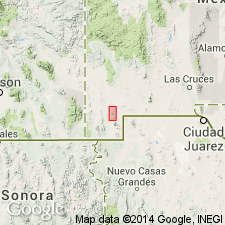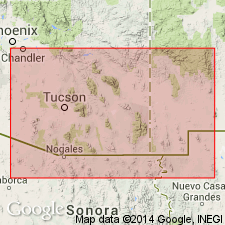
- Usage in publication:
-
- Howells Ridge formation*
- Modifications:
-
- Named
- Dominant lithology:
-
- Andesite
- Shale
- Limestone
- AAPG geologic province:
-
- Pedregosa basin
Summary:
Pg. 533, figs. 2, 4; USGS Prof. Paper 208, p. 21-23, pl. 1, 1947. Howells Ridge formation of Bisbee group. Lower part consists commonly of red beds of mudstone, shale, limestone, sandstone, and conglomerate; locally beds are gray to black. There is transition along the strike from one kind of rock to another within very short distances. Topmost part of formation in Eureka section consists of massive and thin-bedded black limestone and massive crystalline creamy white limestone. In Sylvanite part, the limestone at the top is much thinner than in the Eureka part. Locally the formation contains a layer of andesite flows and breccia whose thinner parts grade into purple shaly mudstone and arkosic volcanic grit. Thickness approximately 4,900 feet in Sylvanite section; may range from 1,100 to 5,200 feet in Eureka section. Conformably underlies Corbett sandstone (new) of Bisbee group; disconformably overlies Hidalgo volcanics (new) and in some places Broken Jug limestone (new), both of Bisbee group. Is fossiliferous; carries ORBITOLINA and coquina-like EXOGYRA. Age is Early Cretaceous (Trinity). Report includes geologic map.
Named from high cliff-capped ridge in Eureka section that is composed entirely of rocks of this formation, Little Hatchet Mountains, southwestern NM (Pedregosa basin and Basin-and-Range province). Howells Ridge in northern part of T. 28 S., R. 16 W., and in southern part of T. 27 S., R. 16 W. [According to GNU records (USGS DDS-6; Denver GNULEX, Mar. 18, 1986), type locality not designated.]
Source: US geologic names lexicon (USGS Bull. 1200, p. 1822-1823); supplemental information from GNU records (USGS DDS-6; Denver GNULEX).

- Usage in publication:
-
- Howells Ridge Formation*
- Modifications:
-
- Overview
- Areal extent
- AAPG geologic province:
-
- Pedregosa basin
- Basin-and-Range province
Summary:
Is formation in Little Hatchet Mountains, Hidalgo and Grant Cos, AZ in the Pedregosa basin and Basin-and-Range province. Together with Playas Peak Formation and Broken Jug Limestone of same area, all are interpreted to be faulted repetitions of the same unit. Is not considered part of Bisbee Group; changed from previous work by Lasky (1947). Bisbee Group not used locally in this paper. "Disconformable contact" at base (Lasky, 1947) is believed to be a fault. Conformably underlies Corbett Sandstone (Albian). Thickness (following Lasky, 1947) is about 5,000 ft. Upper few hundred feet is characterized by thick-bedded to massive rudistid-bearing bioherms and ORBITOLINA-bearing beds of Trinity (Aptian and Albian, Early Cretaceous) age. Is correlated with U-Bar Formation (Aptian and Albian) of Zeller, Jr. (1965) in Big Hatchet Mountains on basis of lithology and fossils; upper fossiliferous part correlated with upper member of Mural Limestone in southeastern AZ also using lithology and fossils. Is Neocomian, Aptian, and Albian (Early Cretaceous) age. [See fig. 5 for regional correlation.]
Source: GNU records (USGS DDS-6; Denver GNULEX).

- Usage in publication:
-
- Howells Ridge Formation
- Modifications:
-
- Not used
Summary:
As mapped by Lasky (1938) in the Little Hatchet Mountains, assigned to Hell-to-Finish and U-Bar Formations. [Because of the generally accepted faulted duplication of the sequence in the Little Hatchet Mountains as defined by Lasky (1938), probably most of his Cretaceous units, including Howells Ridge Formation, should be replaced by the better-defined and more widely used terminology of Zeller (1970).] Is of Early Cretaceous age.
Source: GNU records (USGS DDS-6; Denver GNULEX).
For more information, please contact Nancy Stamm, Geologic Names Committee Secretary.
Asterisk (*) indicates published by U.S. Geological Survey authors.
"No current usage" (†) implies that a name has been abandoned or has fallen into disuse. Former usage and, if known, replacement name given in parentheses ( ).
Slash (/) indicates name conflicts with nomenclatural guidelines (CSN, 1933; ACSN, 1961, 1970; NACSN, 1983, 2005, 2021). May be explained within brackets ([ ]).

